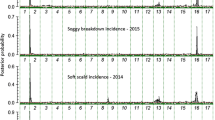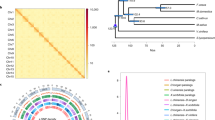Abstract
Most commercial apple cultivars have high to medium chilling requirements and consequently are not grown in regions with warm winters. Furthermore, global climate changes raise the concern that some regions where apples are currently being produced will become unsuitable in the future. Therefore, mapping and understanding the factors governing chilling requirements are important goals towards the breeding of new apple varieties. In this study, we characterized 73 apple accessions: old local accessions, modern cultivars, and selected hybrids, all grown in the Newe Ya’ar germplasm collection in Israel under moderate winter conditions. We measured the time of vegetative bud-break as an indicator of chilling requirements and genotyped the accessions for known genetic markers and for markers we developed by re-sequencing the genome of ‘Anna’, a cultivar with very low chilling requirements. Our results show that while most of the accessions that were characterized as having early bud-break are genetically different from each other, they all share a unique haplotype in a region of ∼190 kb, within a previously identified QTL for bud-break time, on chromosome 9. The alleles in the early bud-break-associated haplotype were not found in any of the late accessions tested, suggesting that the causative difference leading to the variation in bud-break time lays within or near this region, and that there is a common ancestor carrying early bud-break trait of the early accessions tested. Moreover, the markers of the unique haplotype can serve as genetic markers to accelerate the breeding of apple cultivars better adapted to warm climates.



Similar content being viewed by others
References
Abbott AG, Zhebentyayeva T, Barakat A, Liu Z (2015) Chapter six—the genetic control of bud-break in trees. In: Christophe P, Anne-Françoise A-B (eds) Advances in Botanical Research, Volume 74. Academic Press, pp 201–228. doi:10.1016/bs.abr.2015.04.002
Allard A et al (2016) Detecting QTLs and putative candidate genes involved in budbreak and flowering time in an apple multiparental population. J Exp Bot 67:2875–2888. doi:10.1093/jxb/erw130
Amasino RM, Michaels SD (2010) The timing of flowering. Plant Physiol 154:516–520. doi:10.1104/pp.110.161653
Atkinson CJ, Brennan RM, Jones HG (2013) Declining chilling and its impact on temperate perennial crops. Environ Exp Bot 91:48–62. doi:10.1016/j.envexpbot.2013.02.004
Belon P (2012) Travels in the Levant: the observations of Pierre Belon of Le Mans on many singularities and memorable things found in Greece, Turkey. Judaea, Hardinge Simpole Limited
Bianco L et al (2014) Development and validation of a 20K single nucleotide polymorphism (SNP) whole genome genotyping array for apple (Malus × domestica Borkh). PLoS One 9:e110377. doi:10.1371/journal.pone.0110377
Bielenberg D et al (2008) Sequencing and annotation of the evergrowing locus in peach [Prunus persica (L.) Batsch] reveals a cluster of six MADS-box transcription factors as candidate genes for regulation of terminal bud formation. Tree Genet Genomes 4:495–507. doi:10.1007/s11295-007-0126-9
Bowcock AM, Ruiz-Linares A, Tomfohrde J, Minch E, Kidd JR, Cavalli-Sforza LL (1994) High resolution of human evolutionary trees with polymorphic microsatellites. Nature 368:455–457
Brooks RM, Olmo HP (1972) Register of new fruit and nut varieties: second edition, 2 edn. Univ of California Press, Berkeley
Campoy JA, Ruiz D, Egea J (2011) Dormancy in temperate fruit trees in a global warming context: a review. Sci Hortic-Amsterdam 130:357–372. doi:10.1016/j.scienta.2011.07.011
Celton JM, Martinez S, Jammes MJ, Bechti A, Salvi S, Legave JM, Costes E (2011) Deciphering the genetic determinism of bud phenology in apple progenies: a new insight into chilling and heat requirement effects on flowering dates and positional candidate genes. New Phytol 192:378–392. doi:10.1111/j.1469-8137.2011.03823.x
Chen M et al (2016) Genome-wide identification of WRKY family genes in peach and analysis of WRKY expression during bud dormancy. Mol Gen Genomics 292:1319–1332. doi:10.1007/s00438-016-1171-6
DePristo MA et al (2011) A framework for variation discovery and genotyping using next-generation DNA sequencing data. Nature Genet 43:491–498 http://www.nature.com/ng/journal/v43/n5/abs/ng.806.html#supplementary-information
Felsenstein J (1985) Confidence limits on phylogenies: an approach using the bootstrap. Evolution 39:783–791. doi:10.2307/2408678
Felsenstein J (1993) PHYLIP: phylogenetic inference package, version 3.5 c. Department of Genetics, University of Washington, Seattle
Goor A, Spiegel P, Barak D (1962) The apple (in Hebrew). Government of Israel, Ministry of Agriculture, Publication devision, Tel Aviv
Grasovsky A, Weitz J (1933) Apple growing in Palestine, Agriculteral leaflets, vol 30. Department of Agriculture and Forests, Palestine
Gur-Arieh J (1995) Abba Shel Anna. The work of Abba Stein in breeding of deciduous fruit varieties in Israel (in Hebrew). Fruit Board of Israel, Tel Aviv
Hauagge R, Cummins JN (1991) Genetics of length of dormancy period in Malus vegetative buds. J Am Soc Hortic Sci 116:121–126
Hauagge R, Cummins JN (2000) Pome fruit genetic pool for production in warm climates. In: Erez A (ed) Temperate Fruit Crops in Warm Climates. Springer, pp 267–303
Heide OM, Prestrud AK (2005) Low temperature, but not photoperiod, controls growth cessation and dormancy induction and release in apple and pear. Tree Physiol 25:109–114. doi:10.1093/treephys/25.1.109
Holland D, Bar-Ya’akov I, Hatib K (2015) Apple genetic resources in Israel. J Am Pomol Soc 69:186–200
Jerzmanowski A (2007) SWI/SNF chromatin remodeling and linker histones in plants. Biochem Biophys Acta 1769:330–345. doi:10.1016/j.bbaexp.2006.12.003
Kitamura Y, Takeuchi T, Yamane H, Tao R (2016) Simultaneous down-regulation of DORMANCY-ASSOCIATED MADS-box6 and SOC1 during dormancy release in Japanese apricot (Prunus mume) flower buds. J Hortic Sci Biotechnol 91:476–482. doi:10.1080/14620316.2016.1173524
Langmead B, Salzberg SL (2012) Fast gapped-read alignment with bowtie 2. Nat Methods 9:357–359. doi:10.1038/nmeth.1923
Lassois L et al (2016) Genetic diversity, population structure, parentage analysis, and construction of core collections in the French apple germplasm based on SSR markers. Plant Mol Biol Rep 34:827–844. doi:10.1007/s11105-015-0966-7
Legave J-M, Guédon Y, Malagi G, El Yaacoubi A, Bonhomme M (2015) Differentiated responses of apple tree floral phenology to global aarming in contrasting climatic regions. Front Plant Sci 6:1054. doi:10.3389/fpls.2015.01054
Matityahu A, Stern RA, Schneider D, Goldway M (2005) Molecular identification of a new apple S-RNase—S29—cloned from ‘Anna’, a low-chilling-requirement cultivar. Hortscience 40:850–851
Micheletti D, Troggio M, Zharkikh A, Costa F, Malnoy M, Velasco R, Salvi S (2011) Genetic diversity of the genus Malus and implications for linkage mapping with SNPs. Tree Genet Genomes 7:857–868. doi:10.1007/s11295-011-0380-8
Miller E Sherman W (1980) Origin and description of ‘Dorsett Golden’ apple. In: Proc Fl St Hortic Soc. pp 108–109
Minch E, Ruiz-Linares A, Goldstein D, Feldman M, Cavalli-Sforza L (1997) MICROSAT: a computer program for calculating various statistics on microsatellite allele data. Stanford University, Palo Alto
Oppenheimer C, Slor E (1968) Breeding of apples for a subtropical climate. Theor Appl Genet 38:97–102. doi:10.1007/bf00934198
Pommer CV, Barbosa W (2009) The impact of breeding on fruit production in warm climates of Brazil. Rev Bras Frutic 31:612–634
Porebski S, Bailey LG, Baum BR (1997) Modification of a CTAB DNA extraction protocol for plants containing high polysaccharide and polyphenol components. Plant Mol Biol Rep 15:8–15. doi:10.1007/bf02772108
Porto DD et al (2015) Transcription profiling of the chilling requirement for bud break in apples: a putative role for FLC-like genes. J Exp Bot 66:2659–2672. doi:10.1093/jxb/erv061
Ríos G, Leida C, Conejero A, Badenes ML (2014) Epigenetic regulation of bud dormancy events in perennial plants. Front Plant Sci 5:247. doi:10.3389/fpls.2014.00247
Rumayor F, Martinez C, Vazquez R (2001) Breeding apples for the warm climates of Northeastern Mexico. Acta Hortic 565:63–68. doi:10.17660/ActaHortic.2001.565.9
Sherman W, Lyrene P (2003) Low chill breeding of deciduous fruits at the University of Florida. In: XXVI IHC- Genetics and Breeding of Tree Fruits and Nuts. Ed. J. Janick. Acta Hortic 622:599–605
Stino G (1995) Aspects related to temperate zone fruit production in Egypt. Acta Hortic 409:203–206
Thiel T, Michalek W, Varshney R, Graner A (2003) Exploiting EST databases for the development and characterization of gene-derived SSR-markers in barley (Hordeum vulgare L.). Theor Appl Genetics 106:411–422. doi:10.1007/s00122-002-1031-0
Thomson WM (1880) The land and the book: or biblical illustrations drawn from the manners and customs, the scenes and scenery of the Holy Land. Harper & brothers, New York
Trainin T, Bar-Ya’akov I, Holland D (2013) ParSOC1, a MADS-box gene closely related to Arabidopsis AGL20/SOC1, is expressed in apricot leaves in a diurnal manner and is linked with chilling requirements for dormancy break. Tree Genet Genomes 9:753–766. doi:10.1007/s11295-012-0590-8
Trainin T, Bar-Ya’akov I, Holland D (2015) The genetic components involved in sensing chilling requirements in apricot. In: Anderson JV(ed) Advances in plant dormancy. Springer, pp 159–168
van Dyk MM, Soeker MK, Labuschagne IF, Rees DJG (2010) Identification of a major QTL for time of initial vegetative budbreak in apple (Malus x domestica Borkh.). Tree Genet Genomes 6:489–502. doi:10.1007/s11295-009-0266-1
Velasco R et al (2010) The genome of the domesticated apple (Malus x domestica Borkh.). Nature Genet 42:833–839
Voogd C, Wang T, Varkonyi-Gasic E (2015) Functional and expression analyses of kiwifruit SOC1-like genes suggest that they may not have a role in the transition to flowering but may affect the duration of dormancy. J Exp Bot 66:4699–4710. doi:10.1093/jxb/erv234
Wisniewski M, Artlip T, Norelli J (2015) Overexpression of a peach CBF gene in apple: a model for understanding the integration of growth, dormancy, and cold hardiness in woody plants. Front Plant Sci 6:85. doi:10.3389/fpls.2015.00085
Yordanov YS, Ma C, Strauss SH, Busov VB (2014) EARLY BUD-BREAK 1 (EBB1) is a regulator of release from seasonal dormancy in poplar trees. Proc Natl Acad Sci U S A 111:10001–10006. doi:10.1073/pnas.1405621111
Zhang S et al (2014) Genomic variants of genes associated with three horticultural traits in apple revealed by genome re-sequencing. Horticulture Research 1:14045. doi:10.1038/hortres.2014.45
Acknowledgments
We would like to thank Charles-Eric Durel and Caroline Denance for their help with genotypic characterization with the universal SSR markers, and Allesandro Cestaro for providing a list of heterozygous positions in the Golden Delicious genome v3.0. This work was funded by grant number 203-0947-12 from the Chief Scientist of the Ministry of Agriculture and Rural Development of Israel.
Author information
Authors and Affiliations
Corresponding author
Ethics declarations
Conflict of interest
The authors declare that they have no conflict of interest.
Rights and permissions
About this article
Cite this article
Trainin, T., Zohar, M., Shimoni-Shor, E. et al. A Unique haplotype found in apple accessions exhibiting early bud-break could serve as a marker for breeding apples with low chilling requirements. Mol Breeding 36, 158 (2016). https://doi.org/10.1007/s11032-016-0575-7
Received:
Accepted:
Published:
DOI: https://doi.org/10.1007/s11032-016-0575-7




